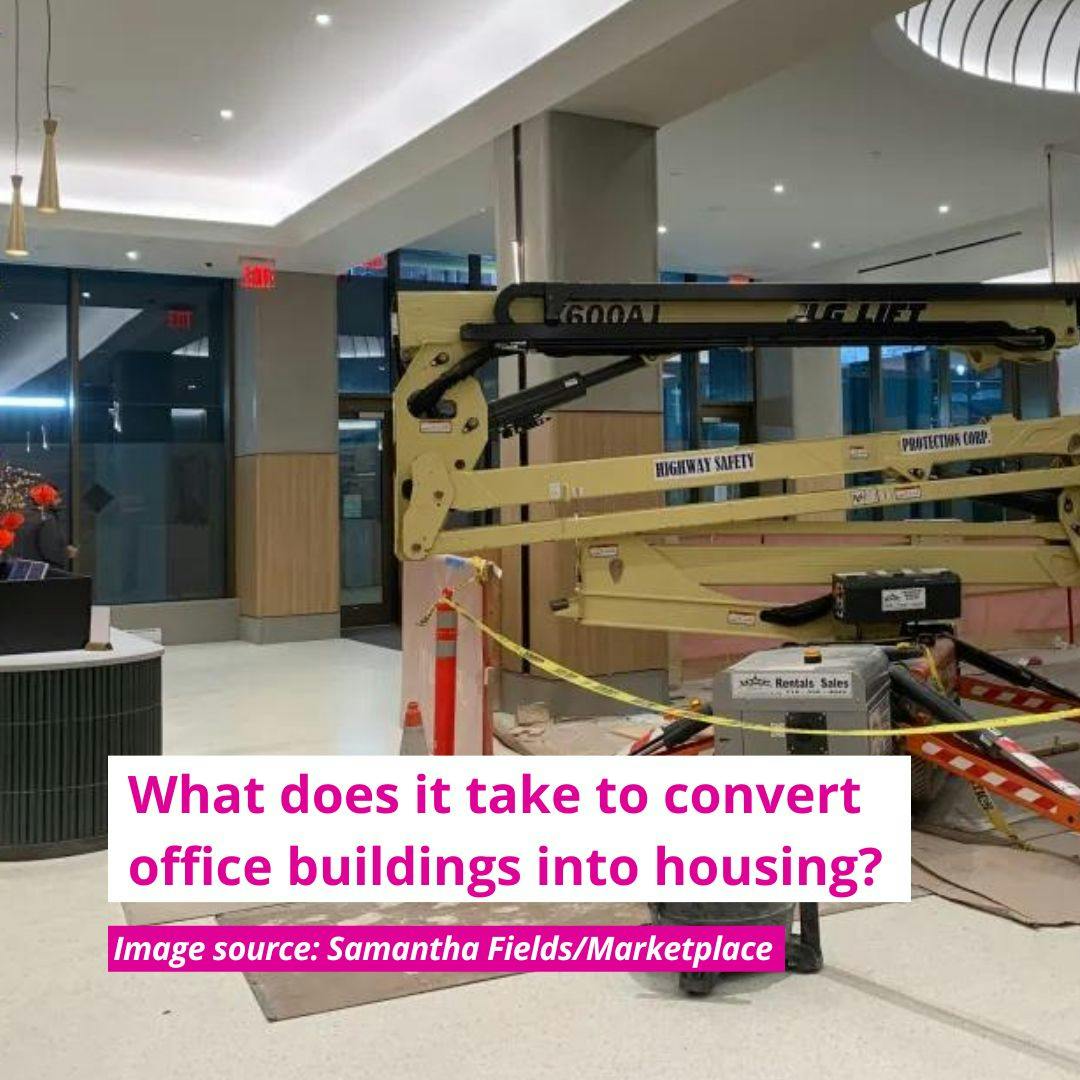What does it take to convert office buildings into housing?
Article source: Marketplace
For half a century, 160 Water St. in New York City’s Financial District was an office building. Today, from the outside, it still looks like one — a 30-story glass box on a street lined with them. But by the front door, there’s a sign now that says, “Pearl House: Now leasing studio, one and two bedroom residences.”
Inside, the lobby is half sleek seating area, half construction zone. That mirrors what’s going on in the rest of the building. Some floors have already been fully transformed from cubicles into ready-to-lease apartments, while others are still in process, with kitchen cabinets and countertops installed and appliances sitting in boxes, waiting.
This is one of four former office buildings in New York City currently being converted into apartments. With a rental vacancy rate of just 1.4% — the lowest it’s been since 1968 — city officials want to see more of these kinds of projects.
Last summer, Mayor Eric Adams’ administration launched an Office Conversion Accelerator program to try to make what’s often a lengthy, cumbersome process smoother for interested building owners. More than 50 have signed up so far.
“Office conversions have the opportunity to help us solve two pressing problems: a housing crisis with skyrocketing rents because we have too few homes, and older office buildings that are struggling to attract tenants,” said Dan Garodnick, director of the Department of City Planning and chair of the City Planning Commission. “Unfortunately, our outdated regulations restrict which buildings can be converted.”
In New York right now, the office buildings that are eligible for conversion are generally those in Midtown built before 1961 and those in lower Manhattan built before 1977.
“We are looking to change those rules to make it a whole lot easier for a commercial office building that is ready to make that move,” Garodnick said. “We think that if we change the rules here, there’s going to be a lot more interest and a lot more opportunities.”
Similar efforts to change zoning and other regulations to make it easier for developers to convert unused office space into housing are underway around the country.
That’s “the No. 1 thing that cities and local governments can do” to make more conversions possible, said Arpit Gupta, associate professor of finance at the New York University Stern School of Business.
But there are other factors that help explain why these kinds of projects are still relatively rare. As of last fall, an analysis from CBRE found that less than 1.5% of office inventory around the country is in the process of being converted to housing.
“There are a number of challenges that explain why it really hasn’t happened so far,” Gupta said. “Big picture, I think that includes the physical challenges of how to literally transform the space from one use to the other. Then, I think there’s a number of financial and economic challenges, which mean that the conversion process may not pencil out financially.”
Malek Hajar, senior project manager of real estate development for the Vanbarton Group, which owns and is converting 160 Water St., said it all depends on the building — like how much it cost to buy, how much it’ll cost to renovate, and its design and layout.
With 160 Water St., several factors made it a good candidate for conversion. For one, Hajar said, “we have windows on all three sides of our building, so we’re lucky in regards to having the light and air.”
To get airflow though, he said they had to replace more than 2,000 windows. When it was an office building, they didn’t open — which is a requirement for apartments.
Other pluses, according to Hajar: The building already had high ceilings, wide staircases and a lot of elevators.
But there were challenges too. “From the elevator to the window line, you have these very long, 100-foot corridors that are just not going to get you the best kind of layouts,” he said. That’s a common issue with these conversions: how to break up the long, dark floors of old office buildings. In this case, they ended up basically cutting a hole and making a shaft — or a void — in the middle of the structure. Another challenge: “Where do all my kitchen sinks and bathroom pipes go?” Hajar said. Typically, on each floor of an office building, “you have a men’s room and a women’s room in a central location, usually back to back on opposite sides of the wall.” And maybe a kitchen. So if you want to turn each floor into 22 apartments, that’s 22 kitchens and at least 22 bathrooms. Maybe more. And the costs add up. Converting 160 Water “was definitely not cheap,” Hajar said with a laugh.
The apartments won’t be either; all are market rate. Studios start around $3,500 a month and two-bedrooms at around $6,000 a month. “We are not receiving any tax subsidies or any credits for our project,” said Joey Chilelli, managing director at Vanbarton Group. “And to be able to do the calculation to make these work, these needed to be market rate.”
New York does not currently offer tax abatements to incentivize conversion projects that include affordable units. Dan Garodnick with the Planning Department said that’s something city officials are pushing for, but it’s up to state legislators and Gov. Kathy Hochul.
“We need an incentive to lock in permanent affordability here,” he said. “That is not something the city can do on its own. That’s where we need the state of New York.”
It’s on the table in Albany this legislative session. But for now, these offices are just being turned into more expensive apartments.

